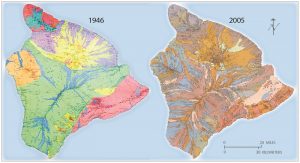VOLCANO WATCH: Happy Birthday Hawai‘i Island Geologic Map!

: A comparison of the 1946 Stearns and MacDonald map (left) and the 1996 BIMP map, digitized in 2005 (right), shows how the understanding of Hawai‘i Island’s geology advanced over half a century. Graphic from USGS General Interest Product 135.
This year marks the 20th anniversary of the Geologic Map of the Island of Hawaii, known affectionately to local volcanologists as the BIMP (Big Island Mapping Project). The first printing of this map was in 1996. Digitized in 2005, it is still in print today due to its popularity and continued use by geologists and other scientists, educators, and land managers and planners, as well as island residents and visitors. It’s also just rather nice to look at.
The Geologic Map of the Island of Hawaii was a decade-long project that updated the 1940s geologic map by legendary Hawaii geologists Harold Stearns and Gordon Macdonald. By comparing the two, you can see how much more detail is provided in the updated map.
The 1996 map was a large undertaking involving more than two dozen geologists and geochronologists, a cartographer, a data technician, and many volunteers.
To gather new information, geologists walked over many miles of terrain, sometimes using helicopters to reach remote areas and sometimes camping for several days. Geologists used aerial photographs to identify subtle patterns in the landscape and then examined the features on the ground to understand their significance. GPS units, new (and cumbersome) technology at the time, helped locate points in highly vegetated areas. Geologists also used new techniques for dating and characterizing lava flows that were not available in the 1940s.
Each geologist compiled field information using aerial photographs, and then transferred the observations and interpretations onto 1:24000 (quadrangle) topographic maps. The cartographer then unified the field geologists’ linework for the final map. All this information was then carefully hand drawn and colored onto the USGS 1:100,000 Hawaii County topographic base map.
The 1996 geologic map publication contains six sheets. One set of three sheets presents the colored geologic map, which displays the origins, shapes, physical compositions, and ages of the lava flows and other surface deposits, including cinder cones, fissure vents, and faults. On the map, colors reflect lava flow age and patterns indicate composition. Permission was granted to reject traditional, subdued USGS geologic map colors to allow geologically recent and active lava flows to enliven the map, just as they do the landscape. Each flow is also labeled with an alpha numeric signature that is keyed to source, age, and type of deposit. For example, “kc5” indicates a spatter or scoria cone (c) from Mauna Loa (k) in age group 5 (0 to 200 years before present). An 18-page text summary of the three colored sheets is included with the geologic map.
The second set of three maps displays the location and some analytical data for 1,783 rock and 242 radiocarbon samples gathered by BIMP geologists. The chemical composition or radiocarbon age of each sample is published in tables in the accompanying 51-page pamphlet. These data add scientific depth to the geologic map, which is much appreciated by geologists and other scientists.
This evolution of the map from 1946 to 1996 illustrates a theme of geologic maps: they are always a snapshot of understanding at a point in time. As insight into geologic processes grows and analytical tools improve, maps will be updated by future generations of scientists. Of course, the 1996 Geologic Map of the Island of Hawaii is already out of date, lacking the last 20 years of Puʻu ʻŌʻō lava flows and missing some important new insights into both Kīlauea and Mauna Loa.
Since the 1996 map was published, Geographic Information System, or GIS, has become the standard tool of map-making and is a powerful way to combine disparate data and look at relationships of information in new ways. Someday, digital geologic maps will be three dimensional and completely interactive, probably in ways we cannot even imagine now.
However, despite new high-tech tools and visualizations, the preparation of geologic maps still involves hefting a pack and spending time on amazing landscapes, sweating and using all our senses as we carefully pick our way across the terrain. For many of us, this is what drew us to geology and keeps us excited at each new outcrop.
Happy 20th birthday to the Geologic Map of the Island of Hawaii. We look forward to its next iteration!
Volcano Activity Updates
Kīlauea continues to erupt at its summit and East Rift Zone. During the past week, the summit lava lake level varied between about 31 and 47 m (102–157 ft) below the vent rim within Halema‘uma‘u Crater. On the East Rift Zone, scattered lava flow activity remained within about 5.7 km (3.5 mi) northeast of Puʻu ʻŌʻō and was not threatening nearby communities.
Mauna Loa is not erupting. Seismicity remains elevated above long-term background levels, but no significant changes were recorded during the past week. GPS measurements show continued deformation related to inflation of a magma reservoir beneath the summit and upper Southwest Rift Zone of Mauna Loa, with inflation recently occurring mainly in the southwestern part of the magma storage complex.
Two earthquakes were reported felt on the Island of Hawai‘i this past week. On Thursday, April 21, 2016, at 12:55 p.m., HST, a magnitude-3.1 earthquake occurred 9.9 km (6.1 mi) northwest of Mauna Kea Summit at a depth of 23.6 km (14.6 mi). On Saturday, April 16, at 8:39 a.m., HST, a magnitude-3.5 earthquake occurred 3.0 km (1.9 mi) southeast of Kīlauea Summit at a depth of 12.8 km (8.0 mi).
Volcano Watch is a weekly article and activity update written by scientists at the U.S. Geological Survey`s Hawaiian Volcano Observatory.













